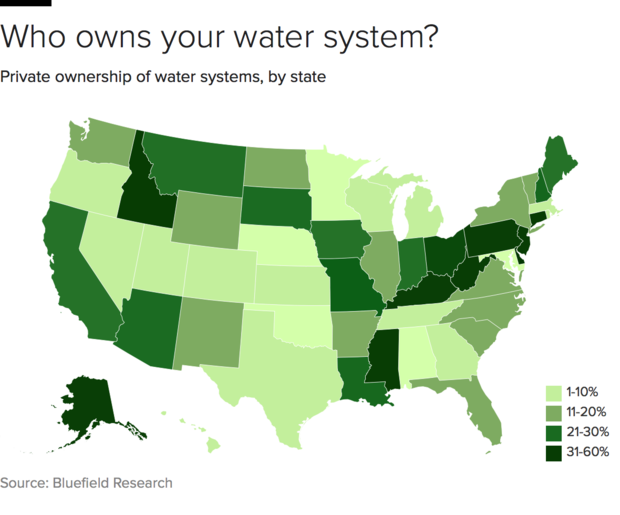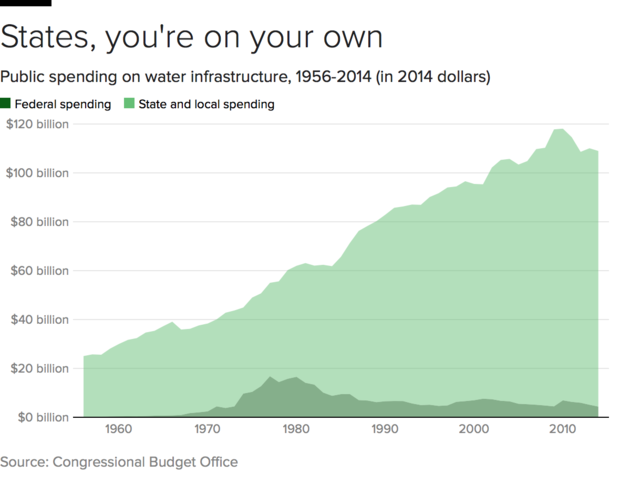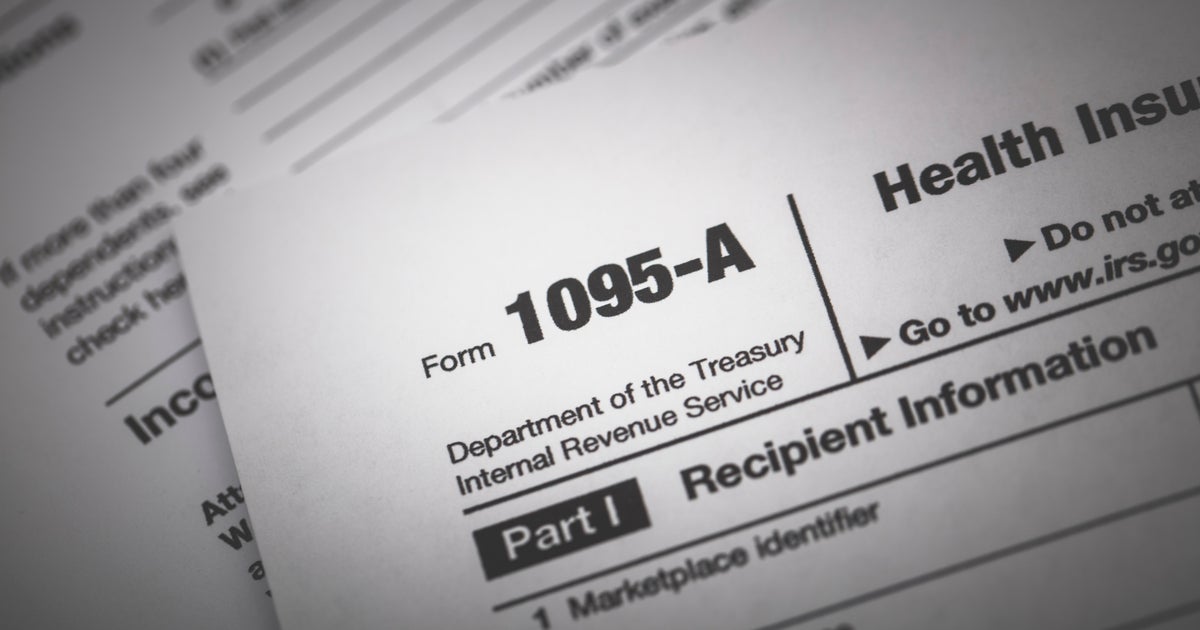Can the private sector save America's aging water systems?
Who owns the water pipes beneath your street?
Increasingly, it is a private company, a shift from the mostly public ownership of the systems used to provide drinking water and remove waste that has prevailed in the U.S. since the early 1900s.
In the first half of 2017, companies spent, or planned to spend, about $2 billion in a total of 53 deals involving water and wastewater utilities. The biggest, energy giant Eversource's recent $1.7 billion acquisition of water company Aquarion in New England, is still pending, according to Bluefield Research. And the Boston-based consulting and research firm expects that trend only to accelerate in the years ahead.
The reason: Many cash-strapped towns, cities and counties around the country can no longer afford to provide water to residents, overwhelmed by the challenge of repairing aging infrastructure and a decades-long decline in federal funding.
While the money spent to privatize water facilities may seem relatively modest, given the US has roughly 78,000 community water and wastewater systems, it's noticeable, according to Bluefield president Reese Tisdale. In part, that's because of the enormous opportunity for private investment in water, which Bluefield pegs at $728 billion.
"There seems to be no shortage of interest, and capital for that matter," he said. "Rather, the challenge for new market entrants, particularly for those looking to secure a platform from which to grow, is scale. Big deals are difficult to find."
Most Americans today are served by publicly owned water and wastewater systems, with small percentages direct wells or cooperatives. Bluefield estimates about 15 percent are owned by private players. An estimated 268 million people relied on public-supply water for their household use in 2010, or about 86 percent of the total population, according to the U.S. Geological Survey.
That wasn't always the case. As cities were growing in the 1800s, many relied on nearby rivers, surface water and local wells, often on private property and sometimes contaminated. Then, led by New York in 1842, major cities began to fund water sources from outside their own limits and began running their own systems.
Still, until it was discovered that untreated water carried disease in the 1850s, most water went untreated. By the turn of the century, demand for safe water was increasing. Cities like Los Angeles began building large pipelines to supply otherwise arid areas. The federal government didn't get involved in funding infrastructure until the Federal Water Pollution Control Act of 1948. Later, when President Richard Nixon established the Environmental Protection Agency in 1970, water quality standards began to be enforced at the federal level.
Beyond repairing old pipes and other infrastructure, a number of factors have municipalities looking for ways to fund, or even replace, their systems.
Perhaps most important, millions of consumers face sharply higher water rates, putting pressure on public officials to respond. The combined water and wastewater bill for a typical U.S. household is up 18.5 percent since 2012, or 4.4 percent per year on average, according to Bluefield. And a recent Michigan State University study found the percentage of U.S. households who will find water bills unaffordable could triple, from 11.9 percent to 35.6 percent, in the next five years.
Another factor: Many systems are falling apart. If water main breaks now seem commonplace, that's because they are. An estimated 240,000 occur every year in the US, according to the 2017 Infrastructure Report Card from the American Society of Civil Engineers (ASCE) released earlier this year.
In recent months, breaks in Brooklyn, Detroit, Chicago, Boston, San Diego and Lincoln, Nebraska, have all made headlines. That's because many of the country's nearly 1 million miles of pipes were laid in the early to mid-20th century, with such infrastructure having a typical lifespan of 75 to 100 years. The ASCE gives the drinking water infrastructure a D grade.
Despite the urgency of making these fixes, the federal government is now less likely to help with the cost. U.S. funding for water utilities peaked in 1976 at $16.9 billion and has since dropped to $4.3 billion in 2014, according to Bluefield. Meanwhile, public water systems also are facing more environmental pressures, with 5,300 in the U.S. listed with serious system violations.
For revenue-starved local governments, then, selling a water system to a private company, either to own or operate, can present a way to solve a debt problem and pay for repairs. It can also eliminate a cost that competes with fire, police and schools.
Since 2013, Missouri, Illinois, New Jersey, Indiana, Pennsylvania have joined California to make it easier for private companies to consider investing in water facilities with legislation that puts a "fair market value" on systems.
"There are more dollars going into the utility network than there used to be," Tisdale said.
States in the mid-Atlantic region have the greatest rate of private water system ownership. Texas and Pennsylvania are also hot spots for acquisitions, with 90 pending and completed deals in 2017, according to the Bluefield report.
Yet buying a system often isn't easy, even for a large, established company. Another obstacle often comes in the form of community opposition, with residents bristling at the idea of a private company owning what's largely seen as public service. That can make purchases long and contentious.
Just this month, New Jersey towns Long Hill and High Bridge rejected a plan to turn their water system over to New Jersey American Water, the state's largest utility, according to Food and Water Watch, a public advocacy group that opposes private ownership.
Privatizing a system can result in higher rates and loss of public control, Food and Water Watch argued.
"Instead of rubber stamping a buyout, town leaders should now begin a thorough and transparent process to explore all the available options for properly investing in the system while maintaining public ownership and control," the group said on its website.
But others strike a deal its residents see as palatable. In West Milford, New Jersey, voters earlier this month approved a sale of the township's Municipal Utilities Authority to Suez Water New Jersey for $12.5 million, according to the Milford Messenger. Funds will go to pay off the township's debt.





